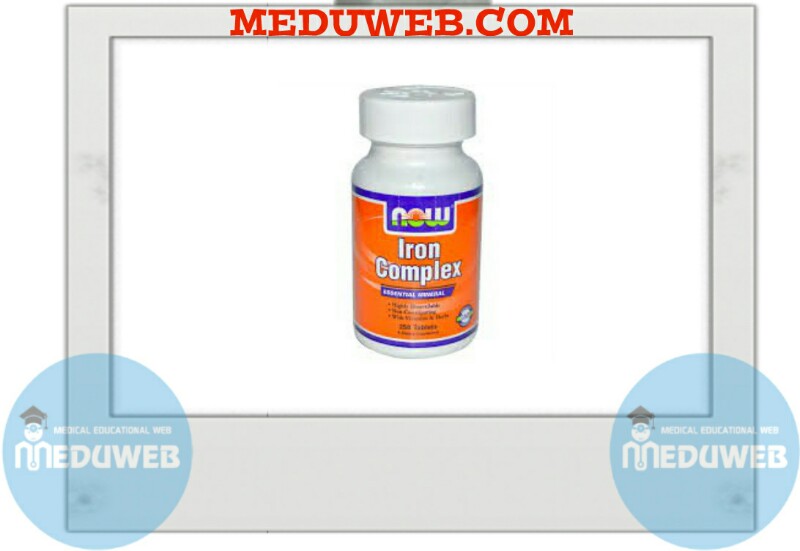Iron Complex Capsules Composition:
Each hard gelatin capsule contains:
Iron peptonate (18% elemental Iron) 100 mg
equivalent to 18 mg Iron
Vitamin B1 1 mg
Vitamin B2 1 mg
Vitamin B6 1 mg
Vitamin B12 0.015 mg
Nicotinamide 10 mg
Folic Acid…. 0.3 mg
Ascorbic acid 20 mg
Copper Gluconate 6.4286 mg
equivalent to 0.9 mg Copper
Manganese Sulphate Monohydrate 3.0769 mg
equivalent to 1 mg Manganese
Betaine HCI 15 mg

Iron Complex Capsules Indications:
Food supplement for iron and vitamins deficiency.
Iron Complex Capsules Contraindications:
Hypersensitivity to any of the components of the drug.
Iron Complex Capsules Dosage:
One capsule daily with food or as directed by the physician.
Iron Complex Capsules Presentation:
A box containing 1,2 or 3 blisters, each of 10 capsules.
Iron Complex Capsules Produced by:
SIGMA Pharmaceutical Industries. Egypt. S.A.E.
Nutritional anemia PPT power point presentation :
1. NUTRITIONAL ANEMIANUTRITIONAL ANEMIA AND VITAMIN AAND VITAMIN A DEFICIENCYDEFICIENCY PRESENTED BY: Samjhana Shrestha M.Sc Nursing 1st year Dept Of Community Health Nursing PION
2. HIDDEN HUNGER The term was coined by WHO in 1986 & refers to the problems associated with the deficiency of 3 essential micronutrients: Iron Vitamin A Iodine
3. NUTRITIONAL ANEMIA DEFINITION It is a disease syndrome caused by Malnutrition. • Acc to WHO – • A condition in which haemoglobin content of blood is lower than normal, as a result of deficiency of one or more essential nutrient, specially iron.
4. Nutritional Anemia • Deficiency of A. Iron B. Folate C. Vitamin B12 D. Protein • corrected by supplementation
5. ANAEMIA • ANAEMIA – Insufficient Hb to carry out O2 requirement by tissues. • WHO definition : Hb conc. < 11 gm % • CDC definition : Hb conc. < 11gm % in 1st and 3rd trimesters and < 10.5 gm% in 2nd trimester • For developing countries : cut off level suggested is 10 gm % – WHO technical report Series no. 405, Geneva 1968 6. WHO cut off criteria OF hb% (in venous blood) Adult man 13 gm/dl Adult woman (non pregnant) 12 gm/dl Adult woman (pregnant) 11 gm/dl Child above 6 yrs 12 gm/dl Child below 6 yrs 11 gm/dl 7. Prevalence –Widespread public health problem with major consequences for human health and socio-economic development –WHO estimates 2 billion people are affected worldwide –>50% due to iron deficiency
8. INTRODUCTION Iron deficiency (ID) is one of the most frequent nutrition deficiency all round the world.( In India – 50%) Its prevalence is higher in children and childbearing age women. Iron deficiency anemia (IDA) mainly affects child behavior and development, work performance and immunity.
9. • WORLD It is a world wide problem with highest prevalence in developing countries. • It affect nearly 2/3 of pregnant and ½ of non pregnant. • INDIA- • Overall , 72.7 % of children up to age of 3 year in urban and 81.2% in rural are anaemic . • It was found that , except for Punjab , all other state had more than 50% prevalence of anaemia among pregnant women. PROBLEM STATEMENT
10. % OF IDA IN INDIA IN VULNERABLE GROUPS Vulnerable groups % of Population with Anemia Adult male 20 children 40 Adolescent girls 56 Adult female 60 Pregnant mothers 60
11. WHO Classification of Anaemia Degree Hb% Haematocrit (%) Moderate 7-10.9 24-37% Severe 4-6.9 13-23% Very Severe <4 <13% Degree Hb% Haematocrit (%) Moderate 7-10.9 24-37% Severe 4-6.9 13-23% Very Severe <4 <13%
12. Iron requirements (RDA) Females 11 – 14 15 15 – 18 15 19 – 24 15 25 – 50 15 51 + 10 Pregnant 30 Lactating 1st 6 months 15 2nd 6 months 15 Category Age (years) RDA – Iron (mg) Infants 0 – 0.5 6 0.5 – 1 10 Children 1 – 3 10 4 – 6 10 7 – 10 10 Males 11 – 14 12 15 – 18 12 19 – 24 10 25 – 50 10 51 + 10
13. Sources of Iron There are 2 types of iron in the diet; haem iron and non-haem iron Haem iron is present in Hb containing animal food like meat, liver & spleen Non-haem iron is obtained from cereals, vegetables & beans Milk is a poor source of iron, hence breast-fed babies need iron supplements
14. HIGH RISK FACTORS
15. Causes of IDA • Increased demand for iron – Rapid growth in infancy or adolescence – Pregnancy – Erythropoietin therapy • Increased iron loss – Chronic blood loss – Menses – Acute blood loss – Blood donation – Phlebotomy as treatment for polycythemia vera •Decreased iron intake or absorption -Inadequate diet -Malabsorption from disease (sprue, Crohn’s disease) -Malabsorption from surgery (post- gastrectomy) -Acute or chronic inflammation
Iron Complex Capsules


